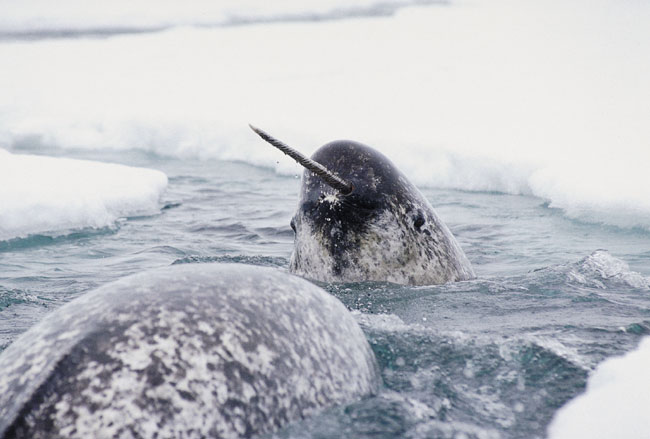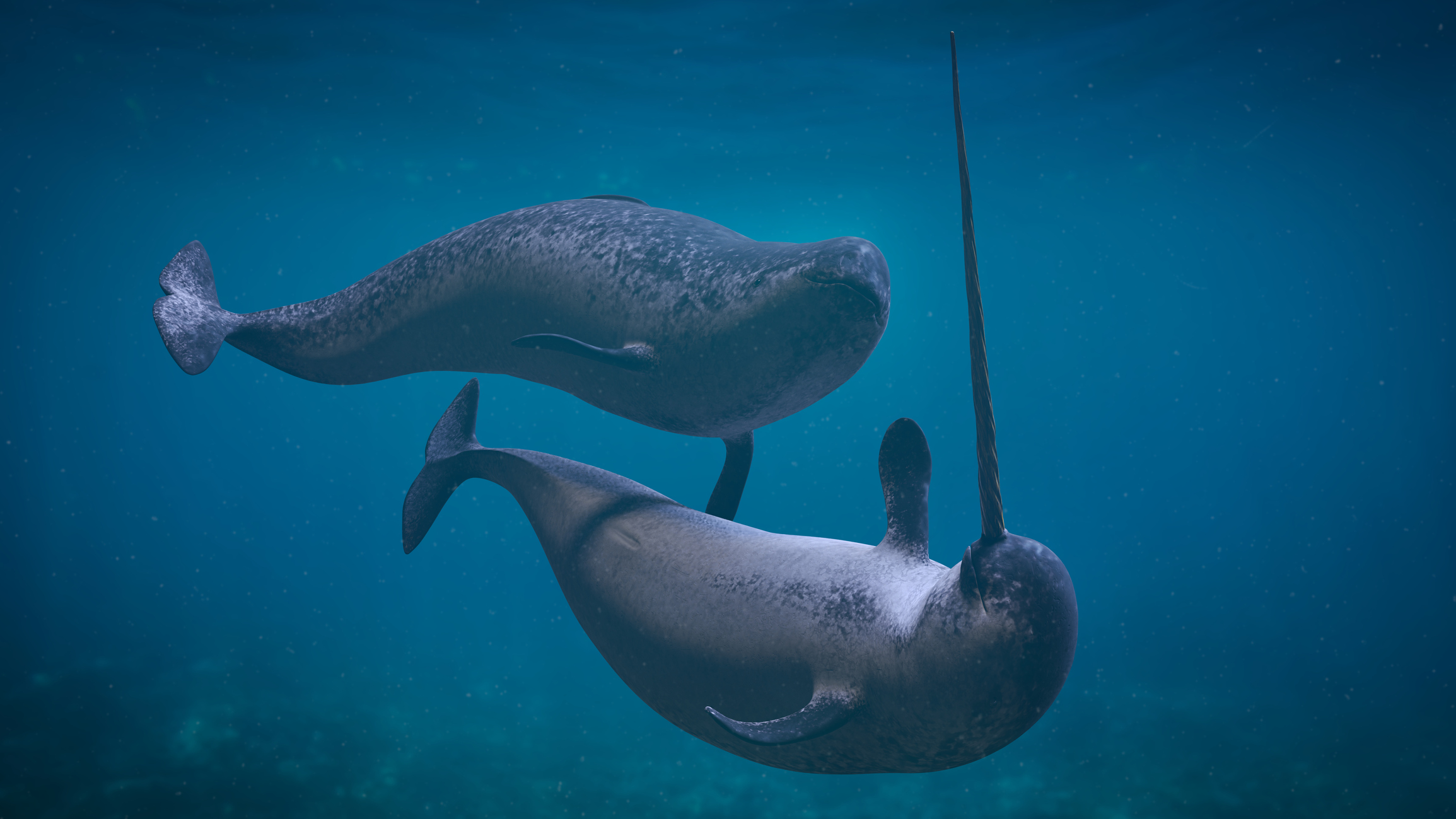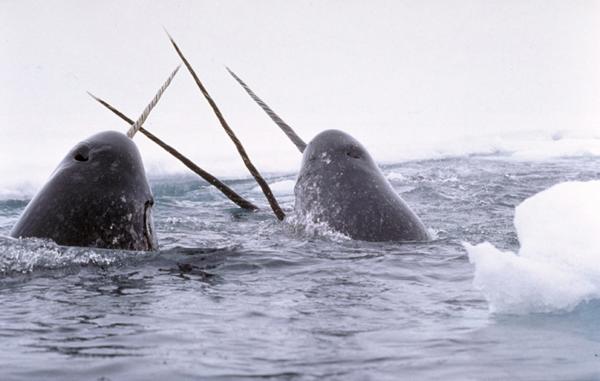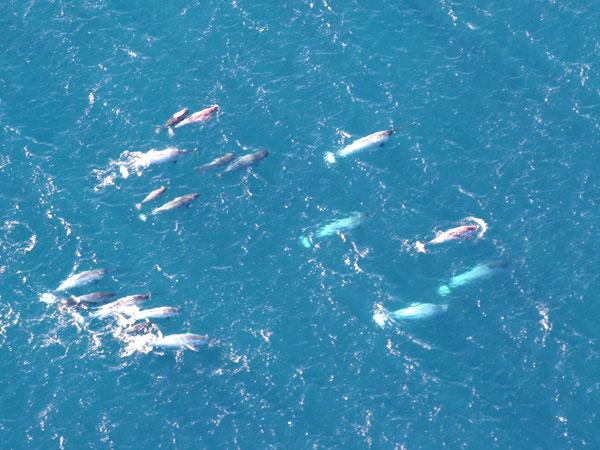Narwhals: Mysterious unicorns of the sea
Learn all about one of the weirdest creatures on Earth.

The narwhal is an elusive, mysterious resident of the remote Arctic. The species, a relatively small whale adapted for extreme icy environments, is known for growing a characteristic spiral tusk that resembles the historical portrayal of a unicorn’s horn.
The name "narwhal" comes from the Norse words "nar" (corpse) and "hval" (whale). According to the National Oceanic and Atmospheric Administration (NOAA), the name refers to the whale's dappled gray skin, which to sailors resembled that of a drowned person.
Narwhals are an important subsistence resource for Inuit people, a culturally related group of indigenous peoples in Greenland, Canada and Alaska. In Inuktitut, the language used by the Inuit people, there are many words for narwhals that specify size, color and whether they have tusks, as described by the Exchange for Local Observations and Knowledge of the Arctic (ELOKA). The name for the whole species, ELOKA found in interviews with Inuit community members, is “qilalugaq qernertaq,” which means “one that is good at curving itself toward the sky.”
The scientific name for narwhal is Monodon monoceros, or "one tooth, one horn" in Latin.
The narwhal's closest living relative is the beluga whale (Delphinapterus leucas). Both narwhals and belugas belong to the Odontoceti group, or toothed whales. The Odontoceti include dolphins, porpoises, beaked whales and sperm whales, as opposed to Mysticeti, which are made up of filter-feeding baleen whales like blue whales or humpback whales.
Narwhals and belugas are the only two living species within the Monodontidae family — they are more closely related to each other than to any other kind of whale. The two species spend their entire lives in the Arctic Ocean, are similar in size and behavior, and on rare occasions have been known to interbreed.
“They’re one of the most difficult animals to study, in my opinion,” said polar biologist Kristen Laidre, who studies narwhals and other Arctic animals as a scientist and professor at the University of Washington. “They’re just inherently very elusive and sneaky,” she added.
What do narwhals look like?
A narwhal’s most distinctive feature is an impressive spiral tusk. But only some narwhals have these tusks, which are usually grown by adult males only.
Adult male narwhals grow to be about 15 feet (4.6 meters) long and weigh about 3,500 pounds (1,590 kilograms). The tusk — which is actually a long projecting tooth — grows up to 9 feet long (3 m), according to the Polar Science Center at the University of Washington. It’s uncommon, but some males have two tusks, usually one smaller than the other.
Females are often smaller than males, growing to be about 13 feet (4 m) long and weighing about 2,000 pounds (910 kg). Even though scientists generally consider the tusk a male sex characteristic, rare female narwhals also grow a tusk (or even two, according to a 1984 doctoral thesis by McGill University marine biologist Keith Hay).
The skin of a narwhal is mottled black, gray and white on the back, with more white on the belly. The whales are born mostly gray, and as they age develop spots and blotches. An old narwhal may appear almost entirely white, which can make them difficult to distinguish from beluga whales at a distance.

Close up, the whales are easily identifiable. Belugas are pure white and tend to have a lot of loose skin and blubber that forms ridges and flaps around their bodies, according to a 2012 paper from the journal Marine Mammal Science. Narwhals, on the other hand, are sleeker. When touched, Laidre said, “they’re very smooth, and rubbery — like a hard wet innertube.”
Narwhal heads are relatively small and round compared with those of other cetaceans. A narwhal’s pectoral or side fins are also short and round. Unlike whales with dorsal fins that project from their backs, like killer whales or fin whales, narwhals have a short ridge along their back.
Those short ridges make narwhals especially tough to spot, according to Laidre. When she goes looking for narwhals, the best days are cold, clear and still. But a dark, silvery or white-splotched whale with no dorsal fin surfacing gently in a field of dark water and white ice is easy to overlook, she said. Even their breath can be hard to spot: while many whales surface with a burst of condensing air that looks like a sudden, tall cloud, narwhals release a subtle puff of air.
Why do narwhals have tusks?
Although narwhals are considered toothed whales, their mouths don't contain functioning teeth, according to Laidre’s Narwhal FAQ page. In most males, the right canine tooth remains in the skull and never grows out, while the left canine shoots out through the gums in a counterclockwise, spiral pattern to form the long tusk. Rarely, both teeth protrude, giving the narwhal two tusks.
Experts have long speculated about why narwhals have this bizarre, elongated tooth. Some theories suggest that the tusk is a tool for survival, as the whales could possibly use it to break up ice at the surface, spear fish for dinner or dig for meals in the seafloor. But the vast majority of female narwhals don't have tusks, and females tend to live longer than males. Most scientists now think the tusk provides no advantage for survival, but rather acts as a sex characteristic like an elk’s antlers or a peacock’s tail. Those features determine social rank and help a male attract and mate with a female.
This sexual selection theory is supported by observations reported in Laidre’s narwhal FAQ: “During the summertime in the northern Canadian high Arctic bays and fjords (long narrow inlets), male narwhals can be seen carefully crossing their tusks and making a strange, sad whistle.” These behaviors could help males determine a dominance hierarchy, or prepare young males for adult mating activity.
But the tusk may also have another purpose. A 2014 study published in the journal The Anatomical Record found that the narwhal's mysterious tusk is full of sensitive nerve endings that allow the whale to detect changes in the environment, such as fluctuations in temperature and salinity. These findings suggest that the tusk might also be a sensory organ.

Where do narwhals live?
Narwhals live in the Arctic Ocean and around the coastlines of Canada, Greenland, Norway and Russia, according to the World Wildlife Fund (WWF). They can be found in the coastal areas during the summer and farther out at sea during the winter.
Narwhals are the only whales that winter in dense sea ice. That’s important because it makes the animals even more difficult to study.
“When you’re looking for narwhals,” Laidre said, “you’re often in a very beautiful, very cold pristine environment.” But despite the beauty of the area, the water is deep, cold conditions can be dangerous and the ice creates a constantly shifting, unpredictable environment.
But despite the remote, harsh conditions of narwhals’ preferred habitats, there are people who live in proximity to the animals as well, and who have successfully made homes in the far north — in many cases, relying on the narwhal for the majority of their food, nutrients and income.
How do narwhals behave?
Narwhals live in groups, usually pods of three to eight members but sometimes up to about 20 members, according to the MarineBio Conservation Society. The smaller pods tend to come together and form large herds during the migratory season.
Narwhals can swim to depths of at least 4,500 feet (1,500 m), where no light can reach and water pressure exceeds 2,200 psi (150 atmospheres), according to NOAA. These skilled divers stay under the water for about 25 minutes per dive, on average. Their large lungs and flexible rib cage allow them to take in a lot of air, and high concentrations of myoglobin (a molecule in muscle tissue that binds with oxygen) help them use every molecule of that air effectively at depth. Narwhals conserve oxygen during long, deep dives by directing the vital molecules to active organs and muscles only.
Narwhals prey mainly on Greenland halibut, polar and arctic cod, squid and shrimp, and they occasionally supplement their diet with wolffish, capelin and skate eggs. In a 2006 paper from the journal Marine Mammal Science, researchers found that unlike most whale species that migrate toward the poles to feed heavily in the summers, narwhals eat more during the winter than in the summer. That behavior likely allows them to avoid competition with other Arctic whale species.
Biologists estimate that narwhals live to between 30 and 40 years old, according to NOAA. Female narwhals reach sexual maturity at around 4 to 7 years old, compared with 8 or 9 years for males, according to the American Cetacean Society. Their mating season typically falls in April, with males often competing for females. But scientists know very little about the details of the narwhal's mating habits because it's so difficult to observe the reclusive creatures in action.
After a 15-month gestation period, pregnant females move to deep bays or inlets to give birth to their single calves, which are around 5 feet (1.5 m) long and 180 lbs. (82 kg) when born. The American Cetacean Society suggests that female narwhals give birth to one calf about every three years, and each calf stays with its mother for up to 20 months.
The narwhal’s skittish behavior may be as a result of its few but formidable predators: polar bears, killer whales and humans.

Cultural significance
High Arctic communities of Inuit people, native to areas like the northern territory of Nunavut, Canada, and Northwestern Greenland, have a long-standing relationship to narwhals, according to ELOKA. Narwhals provide the humans with high-calorie fat, protein and nutrients, vital and hard to come by in the harsh northern winters.
In one report from the Iqaluit, Nunavut Department of Fisheries and Oceans, an elder explains that in the past, all blubber, meat and even organs were used as food or fuel. Even sinews could be turned into thread for sewing. Narwhal tusks were carved into artworks or sold as-is to support families with few other job opportunities.
But beyond the subsistence relationship, communities considered narwhals to be of cultural importance too. Some Inuit myths feature narwhals, according to Smithsonian magazine, and the act of hunting itself helps to define Inuit culture, whether it be hunting narwhals, belugas, or other Arctic animals.
Narwhals have cultural significance in Europe and other parts of the world as well. Their presence in those cultures was mostly in the form of their tusks, which were once mistaken for unicorn horns. In fact, one 2020 study from the Journal of the History of Dentistry suggests that unicorns only entered into European myth after the first narwhal tusks appeared in markets, making narwhals possibly the inspiration for unicorns in the first place.
Powdered, the substance was used as an aphrodisiac, a medicine and a poison detector, reported another article from Smithsonian magazine. In their intact, spiraling form, narwhal tusks were carved into utensils, scepters, swords and more. At the height of its trade, Smithsonian wrote, narwhal tusk was worth ten times its weight in gold.
Now, narwhal tusk is a protected substance regulated under the Convention on International Trade in Endangered Species of Wild Fauna and Flora (CITES). It is generally illegal to import narwhal tusks into the U.S., although some trade of narwhal products from animals killed before 1972 — the year the U.S. officially adopted the Marine Mammal Protection Act — is allowed.
In the sentencing of a convicted smuggler who illegally brought narwhal tusks into the U.S. from Canada, reported the Bangor Daily News, U.S. District Judge John Woodcock said that the crime of wildlife smuggling was particularly heinous because it affected not just the animals involved, but the whole planet. “The narwhal whale is worth more to the rest of us alive than it could possibly be to someone dead,” the judge said.
Narwhal management today poses a challenge as governments and communities seek to balance conservation with cultural and subsistence requirements.
How do scientists find them and study them?
Marine biologists like Kristin Laidre face all the normal challenges of marine biology: studying fast, strong animals that live long lives almost entirely underwater. It’s generally very difficult to study whales and other animals that migrate thousands of miles every year, and live entirely in salt water where people can’t follow for very long.
But Laidre and her colleagues who study narwhals also have to contend with extreme polar conditions like ice and sub-zero temperatures, often while working far from their homes, supplies and hospitals. Ice and icebergs are constantly-moving obstacles between a researcher or observer and the hidden world of narwhals. Ice can even sweep away or destroy equipment that a researcher leaves behind, like the hydrophones or underwater microphones that record the complex sounds that narwhals make below the surface.
So the researchers look for help from other polar experts: traditional knowledge keepers like local Inuit hunters.
“Scientists have their ways of doing things,” Laidre said. “They go collect data and analyze it, which is great but that’s very different from living in a place and having long observations in a place.” Indigenous hunters, she pointed out, may have the advantage of generations of information on the behavior of ice and the movement of narwhals to add to their own personal experience.
Today, most narwhal research relies on remote sensing and observation, according to Laidre. Technology like hydrophones and underwater sensors that detect sounds, salinity, temperature and more allow researchers to eavesdrop on conditions where narwhals are comfortable, all from somewhere much more comfortable for the researchers. Very high-resolution satellite images can be used to spot narwhals from space, reports a 2021 study from the journal PLOS One. And once an animal has been tagged, satellites can remotely pick up signals tracking that individual’s movements for as long as the equipment lasts — in some cases, over a year, according to this 2003 paper published in the Canadian Journal of Zoology.
Tagging a narwhal isn’t easy, though, and that’s where traditional knowledge is vital once again. Laidre’s research sometimes requires netting a narwhal, and spending 20 minutes or so attaching a tag and collecting information about the netted whale. To do this, she and her team rely on help from indigenous hunters to catch the whales and then, contrary to the hunters’ usual goals, safely let it go again.
Conservation status
The International Union for Conservation of Nature (IUCN) considers the narwhal a species of least concern, meaning their population is not under significant threat. The IUCN estimates that there are about 123,000 mature individuals divided into 12 subpopulations within the Arctic.
But similar to all other Arctic wildlife, narwhals are likely to struggle in the face of climate change. Record warm temperatures in the Arctic have caused sea ice to disappear at an alarming rate.
As ice melts in the north, it has revealed newly accessible resources like minerals, oil and gas, reported the New York Times in 2012. And new shipping channels have become accessible, threatening narwhals and other marine mammals, wrote Laidre and colleagues a 2018 article published in the Conversation.
In fact, research suggests that narwhals are the most vulnerable marine mammals to increased human activity in the Arctic because these isolated creatures are highly sensitive to vessel activity. A 2017 study published in the journal Science found that narwhals respond to stress with one of the most extreme fright responses ever recorded. The narwhal's drastic physiological response and time spent out of homeostasis may have negative effects on their health.
In addition, an increase in ship traffic will likely result in more deadly collisions. Narwhals, similar to other whales, rely on hearing to understand their environment. Human-made sources of noise can interfere with the narwhals' ability to hear and communicate and could inhibit their ability to locate their pod members, find food or mates, navigate and avoid predators.
Narwhals are important members of Arctic life. They provide vital subsistence resources to communities in the far north, and are among the first of the species that could be affected by climate change, according to NOAA. Their response to changing conditions near the pole, the agency wrote, could provide insight into larger changes in Earth’s future.
Additional resources
- Follow the tracks of tagged narwhals with the WWF's narwhal tracker.
- Learn more about narwhal tusk research in this video from the WWF Arctic Program.
- Check out these first-hand interviews about narwhals with Greenland elders, collected and translated by ELOKA.
This article was updated on Nov. 17, 2021 by Live Science contributor Vicky Stein.
Sign up for the Live Science daily newsletter now
Get the world’s most fascinating discoveries delivered straight to your inbox.

Rachel Ross is a science writer and editor focusing on astronomy, Earth science, physical science and math. She holds a Bachelor of Arts in Philosophy from the University of California Davis and a Master's degree in astronomy from James Cook University. She also has a certificate in science writing from Stanford University. Prior to becoming a science writer, Rachel worked at the Las Cumbres Observatory in California, where she specialized in education and outreach, supplemented with science research and telescope operations. While studying for her undergraduate degree, Rachel also taught an introduction to astronomy lab and worked with a research astronomer.










